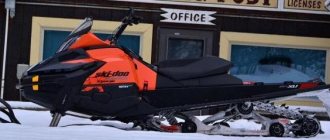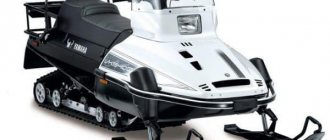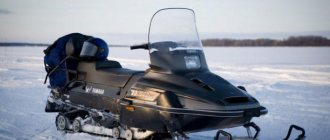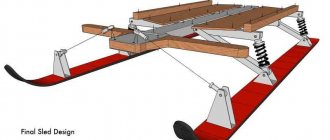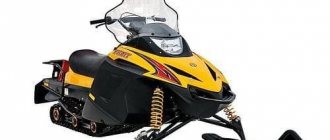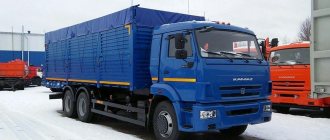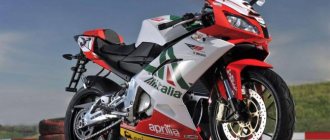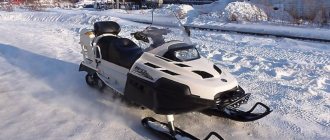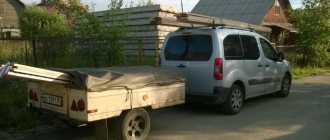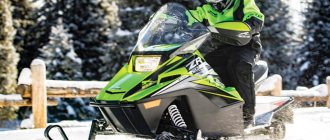We make a snowmobile with our own hands - it couldn’t be easier!
We make a snowmobile with our own hands - it couldn’t be easier!
I made this snowmobile literally in a couple of weekends in the garage at the dacha. Although its design at first glance looks very simple, nevertheless, in terms of cross-country ability in deep loose or wet snow, it is not inferior to most industrially produced snowmobiles.
Several years ago, I built a snowmobile for my nine-year-old daughter with a homemade track made from conveyor belts and plastic water pipes as lugs. At first I had doubts about the reliability of such a track and how the plastic parts would behave in the cold. But during two years of winter operation, no breakdowns or severe wear of the pipes occurred. This inspired me to create a light snowmobile for myself with the same homemade track.
Understanding full well that the smaller the mass of the snowmobile and the larger the supporting area of the caterpillar, the better its cross-country ability in loose and deep snow, I tried to make the design as light as possible. The operating principle of the snowmobile is very simple (Fig. 1). There are four wheels installed inside the caterpillar, which, when moving, roll along a conveyor belt on which lugs are attached. And the caterpillar drive from the motor is carried out by a chain through the driven shaft using special drive sprockets. I took them from the Buran snowmobile.”
With an engine from a conventional walk-behind tractor with an automatic clutch with a power of only 6 hp. you won't accelerate quickly. I planned to ride the snowmobile not on compacted paths, but on loose snow, so I abandoned the soft track suspension and skis to reduce the weight of the snowmobile and simplify the entire design. First I made the caterpillar. A plastic water pipe with a diameter of 40 mm was cut into blanks for lugs 470 mm long. Then I sawed each piece lengthwise with a circular saw into two equal parts. Using the device shown in Fig. 2, I used a wood circular saw to cut plastic pipes for lugs lengthwise.
I attached the lugs to the conveyor belt with two 6 mm diameter furniture bolts with a large semicircular head. When making a caterpillar, it is very important to maintain the same distance between the lugs, otherwise they will run into the teeth of the drive sprockets and the caterpillar will begin to slip and slide off the rollers. To drill holes in the conveyor belt for mounting bolts with a diameter of 6 mm, I made a jig. The holes in the tape were drilled using a wood drill with a special sharpening.
Using such a jig, you can drill 6 holes in the conveyor belt at once to attach three caterpillar lugs. At the store I purchased four inflatable rubber wheels from a garden cart, two drive sprockets from a Buran snowmobile and two sealed bearings No. 205 for the caterpillar drive shaft. I asked a turner to make the drive shaft of the caterpillar and supports for the bearings. I made the snowmobile frame myself from 25x25 mm square pipes. Since the axes of the ski and steering hinges are on the same line and in the same plane, you can use a continuous tie rod without ball ends. Ski turning bushings are easy to make. I welded 3/4″ female plumbing couplers to the front cross member of the frame. I screwed pipes with external threads into them, to which I welded the bipod of the ski steering rack. I recommend using skis from the Argomak children's snow scooter. They are lighter and more flexible, but they need to be equipped with corners for attaching to the snowmobile's rotating stand and a metal undercut at the bottom - for better control of the snowmobile when moving on crusty or compacted snow. The chain tension is adjusted by moving the motor. Driving a snowmobile is very easy. When you increase engine speed with the throttle handle located on the steering wheel, the automatic centrifugal clutch is activated and the snowmobile begins to move. Since the estimated speed of a snowmobile is low (only about 10-15 km/h) and depends on the density of the snow, the snowmobile is not equipped with brakes. It is enough to reduce the engine speed and the snowmobile stops. I will share a few tips that may be useful when repeating this design. 1. I cut the pipe for the tracks lengthwise using a hand-held circular saw for wood, first on one side, then on the other. This makes it smoother than cutting both walls at once. It is more convenient to process small workpieces. If you immediately cut a long pipe lengthwise, then the plastic will melt and the saw blade will jam. 2. Caterpillars can be made of any width. And each designer has the right to choose what is more convenient for him: to make a wide but short track or a narrow and long one. Just remember that with a large caterpillar the snowmobile will be difficult to control and the engine will be more loaded, and with a small one it may fail in loose deep snow. 3. Some of my photos show that there are plastics installed inside the tracks.” These are guide stops for the slide, which should prevent the caterpillar from sliding off the rollers. But during the operation of the snowmobile, the caterpillar did not slide off the rollers even without slipping, so “barrels” can not be installed, which will reduce the weight of the snowmobile. 4. At the end of winter, I completely disassembled the snowmobile to determine its weight. The weight of its individual components turned out to be as follows: caterpillar - 9 kg; drive shaft assembly - 7 kg; two pairs of wheels with axles - 9 kg; engine and steering wheel - 25 kg; pair of skis - 5 kg; frame - 15 kg; double seat with posts - 6 kg. In total, everything together weighs 76 kg. The weight of some parts can be further reduced. Nevertheless, the weight indicator for a snowmobile with a track of this size is quite satisfactory.
The geometric dimensions of my snowmobile are as follows: snowmobile frame length - 2 m; the distance between the axes of the support wheels (rollers) is 107 cm; The width of the caterpillar is 47 cm. The pitch of the caterpillar lugs depends on the thickness of the conveyor belt and it must be selected experimentally (I got 93 mm). I do not provide exact dimensions and drawings of the snowmobile parts, since anyone who plans to repeat the design will be guided by those parts and components that they can purchase or manufacture on their own.
Sergey KHOMYAKOV, Moscow ()
Snowmobile "Ermak": two tracks and one ski. New life to an old concept
July 30, 2016
begins a series of presentations of the new ERMAK snowmobile. The ERMAK snowmobile is designed specifically for those regions where snowmobiles with one ski and two tracks are traditionally used.
Google Share Tweet Pin
From January 29 to April 4, presentations will be held in the cities of Arkhangelsk, Syktyvkar, Yekaterinburg, Surgut, Novy Urengoy (Noyabrsk), Tyumen, Novosibirsk, Krasnoyarsk, Irkutsk and Yakutsk.
The ERMAK snowmobile is designed to replace the BURAN snowmobiles , which are outdated morally, structurally and technologically. Having the same weight, the ERMAK snowmobile is radically different from its great-great-grandfather BURAN:
- Engine power is one and a half times greater;
- Speed is almost twice as high;
- The fuel tank is twice as large;
- The transmission has a low gear;
- Gearbox – gear, without chain;
- Brake mechanism – hydraulic;
- The rear suspension is equipped with gas-hydraulic shock absorbers;
- The ski is on a telescopic stand.
The snowmobile will be produced in two modifications - on a regular platform and on an extended one, with longer tracks. Some parameters of the new snowmobile:
- Air-cooled engine with a volume of 565 cm3 and a power of at least 50 hp, equipped with a power circuit and two carburetors.
- Gear transmission with reverse, with high, low and neutral gears. The gear shift pattern is similar to that of a car with an automatic transmission.
- Modern pendants:
- The front suspension is telescopic with a travel of 150 mm, a plastic ski with an expander and a skate with a carbide insert.
- The rear adjustable suspension is of the roller type, for free movement on ice and other surfaces without snow cover. Equipped with two shock absorbers with a stroke of 190 mm, has improved self-cleaning.
- Modern modular frame with a tubular load-bearing frame, a steel middle rib and a painted aluminum tunnel that prevents ice from freezing.
- New lightweight caterpillar track with increased lugs and lugs on the inside of the track, improving self-cleaning of the track from snow and slush.
- Plastic reinforced bottom of a special shape for planing in deep snow, preventing snow from sticking.
- Dual-mode heated steering wheel grips and throttle trigger.
- The modular Viking seat allows you to increase the luggage compartment of the snowmobile. The entire passenger seat can be removed, including the base and backrest, and the passenger backrest can be installed on the driver's seat.
- A 55 liter fuel tank guarantees a long trip without refueling. Autonomous power reserve – at least 200 km.
- Additional fuel tank 25 l.
- Modern instrument panel and lighting technology provide confidence and comfort.
Buyers will be offered snowmobile models with different engines: a 565 cm3 two-stroke “air-breather” and a four-stroke 800 cc liquid-cooled engine.
For complete driving happiness, additional options are provided, such as a power front bumper, rear, LED headlights, a finder headlight, an electric fuel level sensor, an exhaust gas temperature sensor and an outside temperature sensor.
Advantages
The first SnowFox snowmobile models were released several years ago. There were some shortcomings in snowmobiles of those years. The batch of Snow Fox 200, which was released in 2021, has about 15 improvements to the previous version. The main advantages of this model include:
- Improved spring design, increasing their service life and increasing wear resistance.
- The slides – guides – have been improved. These consumables are in constant contact with the tracks and become covered in water due to contact with snow. Refinement makes it possible to change them less often.
- A fairly wide track has been installed, providing even better traction with snow, better road holding and maneuverability.
- The recoil starter is modified in such a way that the spring does not need frequent washing.
- The main star was strengthened, so the drive power increased - this ensured 100% ride quality.
- There is a speed variator.
- The model has reverse, i.e. reverse speed.
- The ignition switch has functions that protect against water and snow. It is also possible to use a mechanical manual start using a starter.
An important characteristic of the Snow Fox 200 model is its low weight compared to other products - 140 kg. The design is designed for quick disassembly. You can assemble the machine yourself (without additional preparation), following the instructions. In half an hour the snowmobile will be ready for work, and at the end of operation it will be assembled and packed. You can transport the assembled snowmobile in a car trailer.
